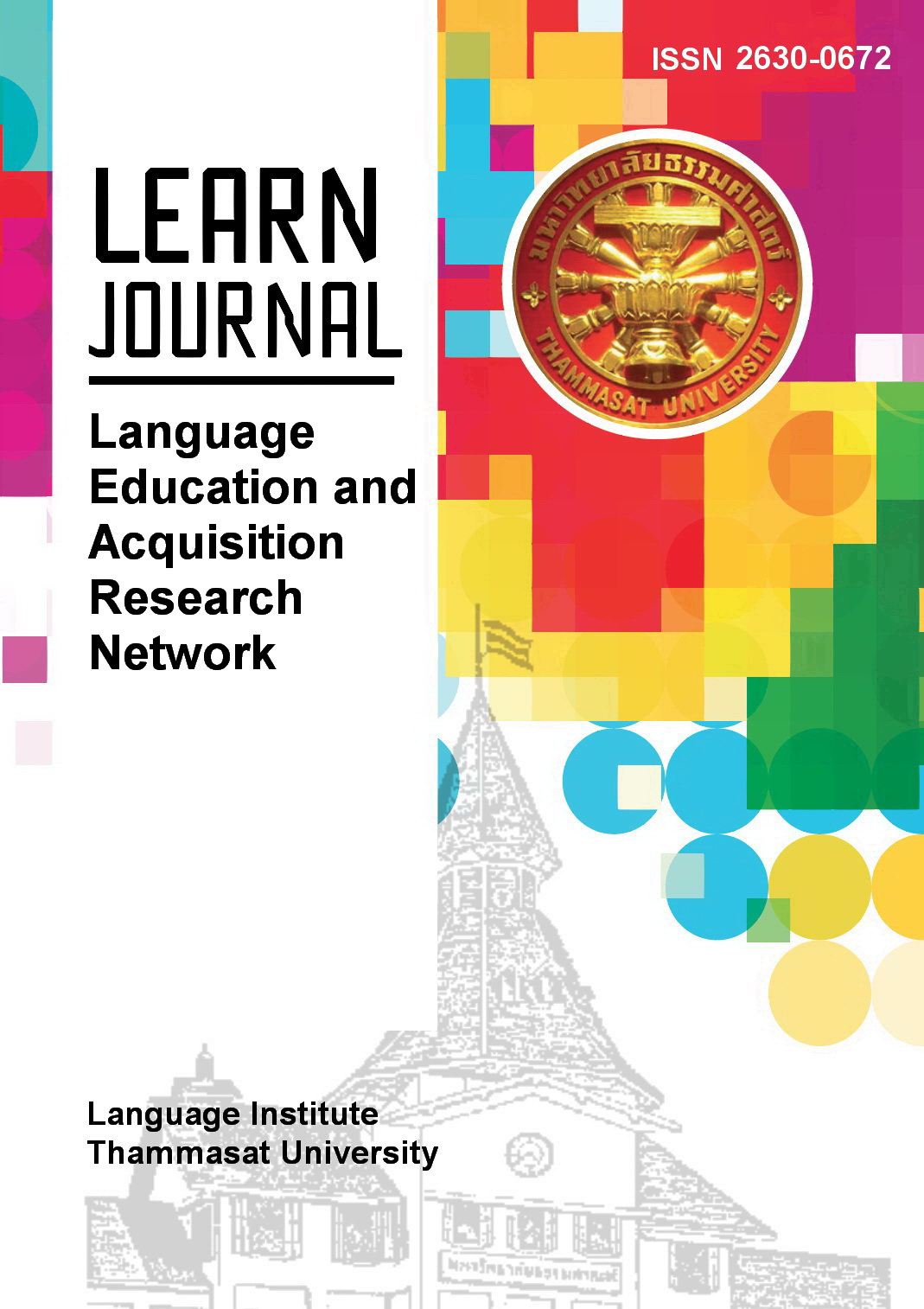Directive Speech Acts of Asian Characters in the Movie Shang-Chi and the Legend of the Ten Rings: Pragmatic Structures and Directive Strategies
Main Article Content
Abstract
Superhero films have become a popular cinematic genre that has attracted the attention of scholars, many of whom focus on the films’ dialogues. Through a pragmatic approach, this small-scale study investigates how directive speech acts are represented by the three Asian characters in the superhero movie Shang-Chi and the Legend of the Ten Rings. Based on previous research, the directive speech acts in the film were extracted and analyzed, and a directive classification taxonomy was created to categorize pragmatic structures and strategies of directive speech acts. Of 342 directive utterances, the characters tend to favor both [H] and (S) oriented structures with more preference toward Single[H] and (S)+[H] structures. Of the 5 directive strategies, Nonsentential, Direct, and Non-Conventionally Indirect/Hint are the preferred strategies over the Conventionally Direct and Hybrid ones. Such preference could be mapped along the directness continuum from the most direct force strategy, Direct directive strategy, to the least direct force strategy, Non-Conventionally Indirect/Hint. The findings may contribute to further exploration of pragmatic features, especially the linguistic constructions of the Nonsentential directive strategy and its function in films, and movie script writing.
Article Details
References
Aldila, L., Noryatin, Y., & Arvian, E. (2020). Directive speech act of character T’Challa in Black Panther movie. ARDU: Journal of Arts & Education, 01(1), 35-43.
Amalia, D., & Adlina, N. (2022). An analysis of illocutionary acts in Shang Chi and the Legend of the Ten Rings movie. International Journal of Progressive Sciences and Technology, 31(2), 154-160. http://dx.doi.org/10.52155/ijpsat.v31.2.4162
Austin, J. L. (1975). How to do things with words. Oxford University Press.
Bach, K., & Harnish, R. M. (1973). A taxonomy of communicative illocutionary acts. In K. Bach & R. M. Harnish (Eds.), Linguistic communication and speech acts (pp. 39-57). The MIT Press.
Blum-Kulka, S., & Olshtain, E. (1984). Requests and apologies: A cross-cultural study of speech act realization patterns (CCSARP)1. Applied Linguistics, 5(3), 196-213. https://doi.org/195-213. 10.1093/applin/5.3.196
Brinker, F. (2017). Transmedia storytelling in the Marvel cinematic universe and the logics of convergence-era popular seriality. In M. Yockey (Ed.), Make ours Marvel: Media convergence and a comics universe (pp. 207-233). University of Texas Press. https://doi.org/10.7560/312490-009
Brown, P. & Stephen C. L. (1987). Politeness: Some universals in language usage. Cambridge University Press.
Byon, A. (2006). The role of linguistic indirectness and honorifics in achieving linguistic politeness in Korean requests. Journal of Politeness Research, 2(2), 247-276. https://doi.org/10.1515/PR.2006.013
Chen, X., & Wang, J. (2021). First order and second order indirectness in Korean and Chinese. Journal of Pragmatics, 178, 315-328. https://doi.org/10.1016/j.pragma.2021
Della, F., & Sembiring, B. (2018). An analysis of directive speech acts by Searle theory in “Sleeping Beauty” movie script. Journal of English Education and Teaching (JEET), 02(1), 22-27.
De Pablos-Ortega, C. (2020). Directive speech acts in English and Spanish filmspeak. Pragmática Sociocultural / Sociocultural Pragmatics, 8(1), 105-125. https://doi.org/https://doi.org/10.1515/soprag-2020-0001
Fernández, R., Ginzburg, J., & Lappin, S. (2007). Classifying non-sentential utterances in dialogue: A machine learning approach. Computational Linguistics, 33(3), 398-427.
Firth, J. R. (1957). Papers in linguistics 1934-195. Oxford University Press.
Forbes, J. (2017, January 17). What are the 10 sub-genres of action movies?. Medium. https://medium.com/@jessicaforbes0191/what-are-the-10-sub-genres-of-action-movies-12e008e19b92
Freudinger, M. (2013). Syntactic perspectives on directive speech acts: A contrastive study. [Doctoral Dissertation, Paderborn University]. https://core.ac.uk/download/pdf/50521038.pdf
Karim, A. (2018, October 10). The Marvel cinematic universe is 61% white, but does that matter?. Forbes. https://www.forbes.com/sites/anharkarim/2018/10/10/the-marvel-cinematic-universe-is-61-white-but-does-that-matter/?sh=68fd43df4482
Kent, M. (2021). Women in Marvel films. Edinburgh University Press.
Klinkajorn, N. (2014). Directives in English and Thai dialogues: A comparative study of English source texts and Thai target texts. NIDA Journal of Language and Communication, 19(21), 73-92.
Koole, S. L., Tops, M., Fockenberg, D. A., & Schnelder, I. K. (2014). The birth and death of the superhero film. In J. Greenberg & D. Sullivan (Eds.), Fade to back: Death in classic and contemporary cinema (pp. 1–23). Palgrave Macmillan. https://doi.org/10.1057/9781137276896_9
Kurniawati, T. (2012). A pragmatic study on indirect speech acts of directive utterances in “The Fellowship of the Ring” movie manuscript [Master’s Thesis, Sebelas Maret University]. https://jurnal.fkip.uns.ac.id/index.php/bhs_inggris/article/view/2906
Leech, G. (2014). Requests and other directives. In G. Leech, (Ed.), The pragmatics of politeness (pp. 134-178). Oxford University Press.
Merican, S. (2022, January 18). Marvel Studios’ ‘Shang-Chi’ And Japanese Film ‘Drive My Car’ Top 2022 Gold List. Forbes. https://www.forbes.com/sites/saramerican/2022/01/18/marvel-studios-shang-chi-and-japanese-film-drive-my-car--top-2022-gold-list/?sh=6af9c435a17a
Nguyen, L. (2021, April 30). 2021 Movies have Asian American men in heroic, attractive leading men roles – Correcting history of discrimination, emasculation, and racism. Hollywood Insider. https://www.hollywoodinsider.com/asian-american-men-heroes-movies-2021/#:~:text=
Osborne, J. (1996). Look back in anger: Play 1. Faber and Faber.
Pérez-Hernández, L. (2021). Speech acts in English: From research to instruction and textbook development. Cambridge University Press. https://doi.org/10.1017/9781108677073
Poppi, F. (2020). “Waiting for your info”: An explanatory look at the communicative strategies deployed to mitigate potentially face-threatening acts in emails. Lingue E Linguaggi, 38, 199-217.
Ryutenbeek, N. (2019). Current issues in the ontology and form of directive speech acts. International Review of Pragmatics, 11(2), 200-221. https://doi.org/10.1163/18773109-01102101
Searle, J. R. (1975). A taxonomy of illocutionary acts. University of Minnesota Press, Minneapolis https://conservancy.umn.edu/handle/11299/185220
Shek, D. K. L. (2022). Mockery, deviants, aliens, and Asians in Marvel films: A media analysis of Asian representation. [Master’s Thesis, Aalborg University]. https://projekter.aau.dk/projekter/files/473810243/10_Semester_THESIS.pdf
Wang, V. X. (2009). Pragmatic shifts in two translations of
fusheng liuji: A descriptive study of request
behaviour. Target, 21(2), 209-234. https://doi.org/10.1075/target.21.2.01wan


